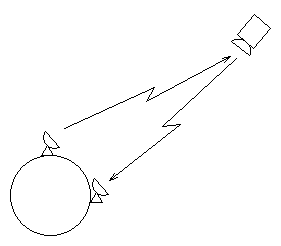Doppler Tracking - The Gravitational Wave Experiment
 Doppler tracking is a technique to accurately monitor the
distance to a interplanetary space probe. A radio signal is sent to the
probe, and retransmitted back to the same or another antenna on ground.
The transmitted and received signals are compared in phase, using an
atomic clock to propagate the phase during the long (several thousands
of seconds) round-trip travel time of the radio signal.
Doppler tracking is a technique to accurately monitor the
distance to a interplanetary space probe. A radio signal is sent to the
probe, and retransmitted back to the same or another antenna on ground.
The transmitted and received signals are compared in phase, using an
atomic clock to propagate the phase during the long (several thousands
of seconds) round-trip travel time of the radio signal.
The very accurate (typically some hundred microns) measurement can be
used to investigate:
the gravity field of bodies (asteroids to planets) that the
spacecraft flies by
the atmosphere of planets and satellites, when the radio link
happens to cross them
and, last but not least, gravitational waves, i.e.
small ripples in the spacetime structure,
expected from Einstein general relativity, that may
cause the Earth-spacecraft distance to oscillate slightly.
Experiments to try to detect gravitational waves have been carried in
1992 and 1993 using the S/C Ulysses and several VLBI radiotelescopes,
including Medicina, Noto and Kashima (Japan). Data analysis is in
progress.
References:
B. Bertotti, R. Ambrosini, S.W. Asmar, J.P. Brenkle, G. Comoretto,
G. Giampieri, L. Iess, A. Messeri, H.D. Wahlquist:
"The Gravitational Wave Experiment", Astronomy and
Astrophysics Suppl. Series 92, 431 (1992).
B. Bertotti, G. Comoretto, L. Iess: "Doppler tracking of spacecraft
with multi-frequency links", Astronomy and Astrophysics,
269, 608 (1993).
B. Bertotti, R. Ambrosini, J.W. Armstrong, S.W. Asmar, G. Comoretto,
G. Giampieri, L. Iess, Y. Koyama, A. Messeri, A. Vecchio,
H.D. Wahlquist:
"Search for gravitational wave trains with the
spacecraft Ulysses", Astronomy and Astrophysics,
296, 13 (1995).
 Doppler tracking is a technique to accurately monitor the
distance to a interplanetary space probe. A radio signal is sent to the
probe, and retransmitted back to the same or another antenna on ground.
The transmitted and received signals are compared in phase, using an
atomic clock to propagate the phase during the long (several thousands
of seconds) round-trip travel time of the radio signal.
Doppler tracking is a technique to accurately monitor the
distance to a interplanetary space probe. A radio signal is sent to the
probe, and retransmitted back to the same or another antenna on ground.
The transmitted and received signals are compared in phase, using an
atomic clock to propagate the phase during the long (several thousands
of seconds) round-trip travel time of the radio signal.